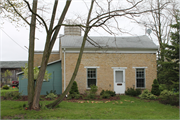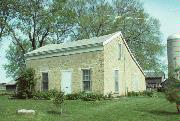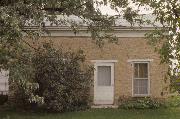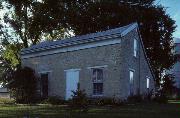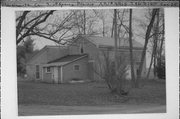| Additional Information: | A 'site file' exists for this property. It contains additional information such as correspondence, newspaper clippings, or historical information. It is a public record and may be viewed in person at the Wisconsin Historical Society, State Historic Preservation Office.
WOOD LINTELS AND SILLS.
THERE IS ALSO A COMPLETE HISTORIC FARMSTEAD LOCATED BEHIND THE HOUSE THAT IS PROBABLY NOT AS OLD AS THE HOUSE BUT WHICH PROBABLY DATES FROM THE LATE 19TH OR EARLY 20TH CENTURIES.
James Jesse Strang was born near Scipio, New York, in 1813. He was admitted to the New York bar as a self-taught attorney in 1836. While practicing law, he also edited a weekly newspaper, taught at a country school, and acted as postmaster. In 1843, he migrated to Burlington with his wife, Mary Perce, to join her brother Benjamin C. Perce and her sister and brother-in-law, Moses and Lydia Smith. Upon arrival, they stayed with Benjamin, who had settled there in 1836, and Strang continued his law practice. Strang’s brothers-in-law, Moses and Aaron Smith, were devout Mormons from around the time of the faith’s beginning by Joseph Smith in 1830. The Smiths converted Strang to Mormonism by January 1844. In February 1844, Strang traveled to the headquarters of Mormon Church in Nauvoo, Illinois, with Aaron Smith and was baptized there personally by Joseph Smith. Before returning to Burlington, Strang was also made a church elder and was commissioned with Moses and Aaron Smith to form a settlement near Burlington for persecuted Mormons.
Months later, the Mormon Church was thrown into upheaval after Joseph Smith’s assassination. Strang returned to Nauvoo to present to the church elder’s two claims for his succession as the new leader of the Mormon Church. The first being that at the time of Joseph Smith’s death, Strang claimed an angel appeared to him and appointing him to be the next leader of the Mormon Church. The second was a letter he claimed to have received, postmarked from Nauvoo and purportedly written by Joseph Smith nine days prior to his death, commissioning Strang to lead the church and move all adherents of the faith to the settlement near Burlington, to be named “Voree.” Brigham Young, another elder claiming succession to Smith, and other church leaders doubted the authenticity of these claims and ultimately excommunicated Strang from the church. Believing his rightful role as church leader, Strang proceeded to excommunicate Young and gathered Nauvoo Mormons to join him. In January 1845, Young led his followers to resettle at Salt Lake City, Utah, which became the home of the Church of Jesus Christ of Latter-day Saints. Meanwhile, Strang purchased 200 acres along the White River and established the settlement of Voree. The name Voree is said to mean “Garden of Peace”. Strang was successful in persuading some of Young’s followers to leave their journey to Utah and join him in Voree, including several relatives of and church leaders close to Joseph Smith. At its peak, the settlement at Voree had a population of 300 to 400 inhabitants, which Strang claimed increased to audiences of 1,500. To this day, both Young and Strang divisions consider themselves to be the one true Church of Jesus Christ of Latter Day Saints founded by Joseph Smith, not acknowledging any of the many other Latter Day Saint sects as legitimate.
In Voree, Strang claimed another angelic visitation during the fall of 1845, this time, telling him to dig beneath a certain oak tree on the nearby “Hill of Promise” to uncover a divine message. Strang and four church elders, Aaron Smith, Jirah B. Wheeler, J. M. Van Ostrand, and Edward Whitcomb, uncovered three copper plates engraved with hieroglyphics which Strang was divinely told only he could translate. According to Strang, the plates, referred to as the Voree Record, had been left there by a prophet and leader of ancient North American inhabitants, named Rajah Manchore of Vorito.
Strang had a divine revelation commissioning his followers to construct a temple at Voree to be the grandest building in the world. Construction began in 1847; never completed, it was demolished in 1856.
James Strang did not have a house of his own at Voree until 1846, when he received a divine revelation that faithful followers should build one for him. It was a one-room log cabin located on the west bank of the White River. It is no longer extant.
From his father’s house at W141 State Highway 11 in the Town of Spring Prairie, Strang began publishing a weekly paper called the Voree Herald in January of 1846 with a printing press acquired from Philadelphia. In November of that year, the name was changed to Zion’s Reveille, and finally to The Gospel Herald in September of 1847. Considered the first newspaper in the region, Strang published legal notices such as mortgage sales, attachments, and deeds for the Burlington area in addition to Mormon literature used in proselytizing throughout the country.
Also in 1846, Strang began searching for a new and more isolated home for his following. The following year he said it had been revealed to him in a vision that they should relocate the community to Big Beaver Island at the northern tip of Lake Michigan, near Mackinac, Michigan. As the island had not yet been opened for settlement, Strang was granted permission by the federal government to operate an Indian mission there in 1847. He began publishing a newspaper there known as The Northern Islander promoting life in what he described as the “New Zion.” During the following two years, more than 1,500 people migrated to the settlement which Strang named St. James after himself.
In 1850, Strang received a divine command to establish an ecclesiastical monarchy. On July 8th of that year, Strang was crowned king of his church. Strang began practicing polygamy at that time. While members of the Young’s church in Utah had been employing the practice before that time, Strang was the first Mormon leader to publicly embrace the doctrine of polygamy when he married four additional wives, named Elvira, Betsy, Sarah, and Phoebe in 1850. His first wife, Mary Perce, did not sanction the practice and returned to Voree. The following year, President Fillmore dispatched soldiers to arrest Strang and bring him to trial in Detroit. Acting as his own defense, Strang was acquitted on lesser charges and returned to Big Beaver Island.
During the fall of 1850, with over 700 voters among his followers, Strang was elected to Mackinac County government, during which term he moved the county seat to St. James. In 1853, Strang was elected to the first of two terms in the Michigan State Legislature.
Strang was shot by two disenchanted followers in the summer of 1856. He was brought back to Voree accompanied by his four wives, died 10 days later, and was buried in the Voree cemetery. After Strang left Big Beaver Island, his church fled as their settlement was destroyed by angered mainlanders. Strang’s remains were reinterred at Burlington Cemetery in 1876. |
|---|

